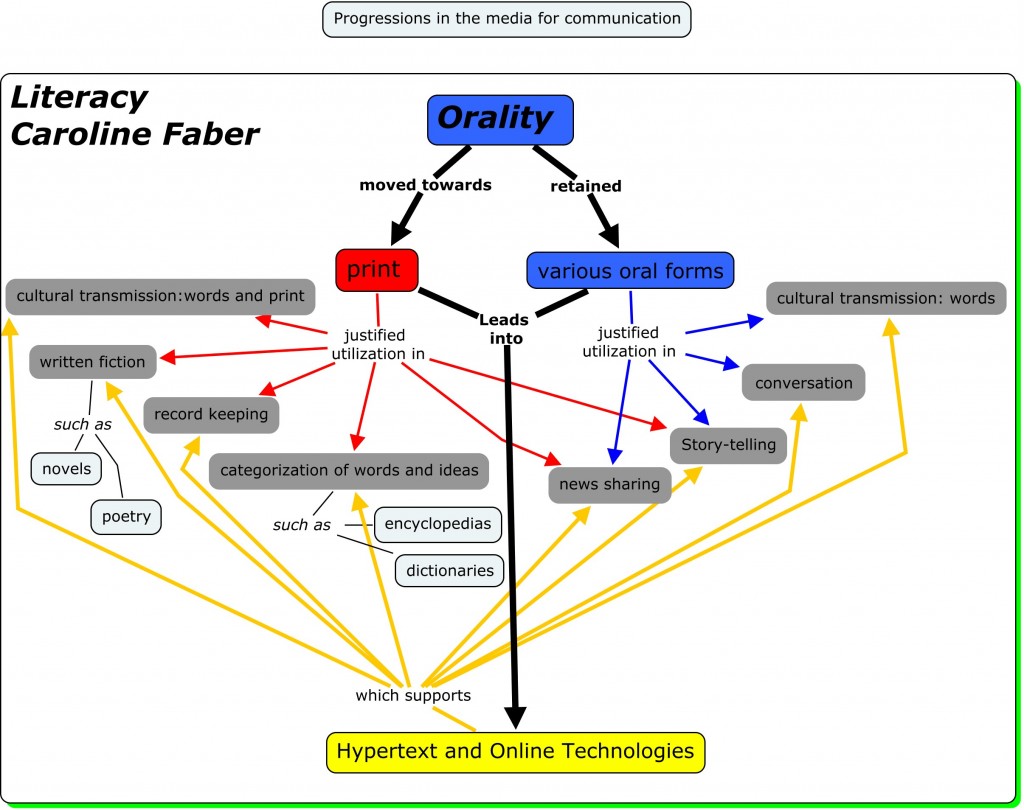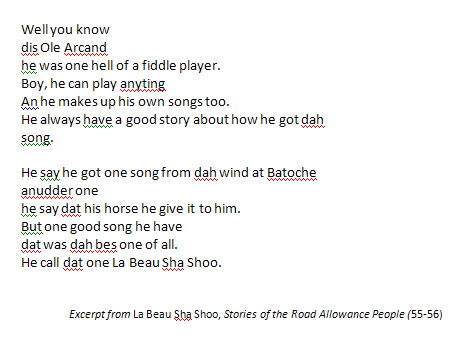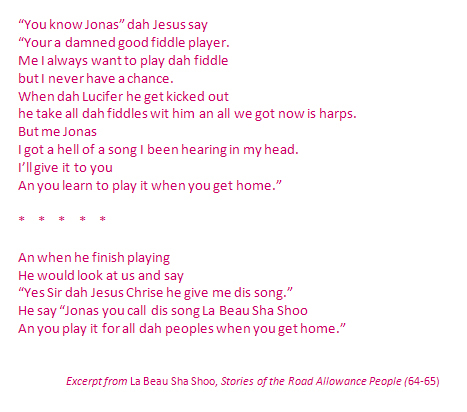This paper examines the issue of effective integration of online tools and technology into classrooms. For me, there is a deeper issue other than funding and support that is stalling education’s participation in the technological shift. This deeper issue revolves around the remediation conflict currently occurring between the classroom space and the online space. Developing an effective model for integration involves understanding this conflict and creating an online tool that allows teachers to make the transition towards effective integration of online technology into their classrooms.
Below is the research paper. I’ve posted the paper at Zoho with support materials.
Click here to see this online version…
A Model for Integrating Online Technology
Drew Murphy
The Remediation of Classrooms
Business, communications, politics, media, are all experiencing significant change under the influence of online technology innovation. Yet, as we witness technology inducing staggering change in the world at large, classrooms are conspicuously absent in their participation in this phenomenon. Many people will point to inadequate funding, lack of technical support and professional development as significant obstacles (Tech Talk Survey, 2006) However, new technologies are eroding these barriers. Essentially, there is a deeper issue that is stalling education’s participation in the technological shift. This deeper issue revolves around the remediation conflict currently occurring between the classroom space and the online space. Bolter refers to this remediation issue in terms of print text and digital text where “This debate turns on the question: which form is better at constituting the real, the authentic, or the natural” (1995, p.43) This debate holds true for classrooms and computers as well. For print centric classrooms to participate more actively in the greater technological shift, teachers and technology need to reconcile at a deeper classroom cultural level, pay homage to one another and restructure together in incremental but important ways.
The Impact of Web 2.0 Online Services
With the development of new online technologies, the improvement of hardware and software systems, and the access to high speed internet connections, new possibilities are available for classroom teachers. In the new millennium, the web has exploded with interactive content, social networking and user generated content functionality. Coined as Web 2.0 (O’Reilly, 2005”), these online applications and resources are creating new possibilities for classroom technology integration. Needing little or no training and often provided for free, barriers around cost and onsite support traditionally inhibiting technology integration are eroding.
For teachers in particular, there are a multitude of services for creating interactive slideshows, photo galleries, timelines, flowcharts, sketchpads and more. However, a closer look reveals that most of the applications are aimed at a broad market of internet users and not classrooms specifically. Without specific classroom conscious remediations many of the applications don’t adapt well to the time pressured practices of traditional classrooms. Wikis and blogs are somewhat of an exception.
Wikis and blogs are getting serious attention as tools that offer classroom integration possibilities. These tools create opportunities for new online teaching methodologies which emphasize creative, resource rich, self-directed learning experiences for students. (Bruns, 2005). Yet these, powerful, flexible Web 2.0 tools still require significant technical understandings on the part of classroom teachers. These online spaces also create a whole new environment of engagement , access and control that represent significant shifts away from traditional classroom cultures (Bruns, 2005), where the teacher still leads the learning process, orchestrates classroom talk, designs and sets the activity schedule and measures learning progress. Thus Wikis and blogs, although pedagogically valuable, are broad and challenging tools that remain as peripheral, somewhat complicated innovations.
For most teachers, web 2.0 tools are complementary resources offering novelty engagement or broad innovations requiring leaps of professional faith. It is the technology itself that is often the innovation. The ability to create the slideshow, the video, the flowchart in an online environment is an innovation in and of itself but it is not an innovation that directly impacts the inner workings of the classroom delivery model. They are innovations that represent radically new modes of teaching and genres of communication for teachers. Can they be beneficial for students? Yes. Do they represent innovations that can readily integrate into traditional classroom methods and practices, unlikely.
The Nature of Classrooms Today
Understanding why technology integration in schools is happening slowly, against the backdrop of rapid social integration, involves understanding certain key aspects of classroom cultures. Classrooms are pre online technology environments. Technology, in general, is not new to these classrooms where the use of overheads, tv’s, vcr’s and projectors, has been common for years. However, these older technologies have become part of the methods and practices developed by teachers over many years and are deeply engrained in the culture of the classroom medium. At its core, the classroom model is a learning production model within a hierarchical leadership structure. The are exceptions and pockets of innovation but in general for most classrooms, the teacher leads the learning process, orchestrates classroom talk, designs and sets the activity schedule and measures learning progress.( Helena Austin, et al, 2002) Resources such as desks, textbooks, handouts, whiteboards, overheads, projectors, etc.., all contribute to the efficiency and productivity ethos of this curriculum delivery system. Classrooms are still primarily print based cultures that value and promote print based literacy. And, it is a model where, over the years teachers have discovered and exercised numerous efficiencies and economies of scale to create effective learning environments. Persuading teachers to integrate new technology and the accompanying new methods and practices into this kind of deeply entrenched classroom culture requires a special type of innovation.
Looking for Incremental Innovation
Looking at the characteristics of effective innovations, we find research shows that incremental change to current practices is a common feature of effective innovation (Marquis, 1969). This makes sense for classrooms too. Relevant innovation for teachers means constructing web tools that make key incremental improvements to current classroom practices. Radical innovations, although offering possible pedagogical improvements, are typically much more difficult to integrate. Effective incremental innovation comes from understanding how teachers work in classrooms and how they currently engage with the online environment.
As previously mentioned, classroom teachers typically lead the learning process, orchestrate classroom talk, design and set the activity schedule and measure learning progress. Within this general process, teachers use a variety of tools and resources including the internet. In particular, research indicates that the majority of teachers use the web most often to look for online content that might be used to support their curriculums. (Kenton, 2005, NSW Department of Ed., 2007). Numerous content aggregation sites aimed at teachers such as WatchKnow , 2Learn and Teachertube attest to the usage of the web as a major source of classroom content. Connected to this usage is the act of browsing for websites as a common teacher activity (Project Tomorrow, 2008) as evidenced by the popularity of bookmarking services such as Del.icio.us. All of this online activity makes perfect sense in the context of a classroom. Using web tools to find appropriate and engaging online content is itself an incremental innovation that both builds on and adds to the methods and practices teachers currently use in classrooms. The question for educators is what are the next incremental innovations that might induce effective integration further.
Discovering the Moment of Remediation Conflict
If we build on the current online behaviors of teachers and link them back to their fundamental classroom methods and practices, we can start to piece together an incremental innovation model that is both realistic and transformative. Research shows that teachers inherently understand the value of technology to enhance teaching and learning. (Teacher Talk, 2006). Furthermore, the popularity of web browsing as an online teacher activity and the use of the web as a source of content demonstrates a fundamental connection the web has with traditional classroom practices. In other words, the web has content and classroom teachers will seek it out to use it. The question thus arises as to how do teachers integrate this web content into classrooms.
Studies show that teachers typically accompany visits to websites with paper handouts of instructions and questions.(Kenton, 2005 NSW Department of Ed., 2007) Other typical integration practices involved writing instructions on the board or giving oral instructions regarding the teacher’s desired usage of web content. Herein, lies the point of conflict between classroom spaces and online spaces. Traditional print based mediums and teacher oratory are being used to cast off students into online content spaces. This bridging of print to screen is a radical transformation because the nature of the digital screen “changes methods of organization, structure, consultation, even the appearance of the written word.” (Chartier,1995, p.15). Having students switching between paper based information or board posted instructions as they interact with browser based content is a major obstacle to effective integration of online content into classrooms. The changing modalities of paper and screen interrupts the cognitive flow for the student as they mentally re-focus back and forth between the conflicting stimuli of what McCluhan called the hot precise and visually arresting nature of print text versus the cooler meaning making nature of online multimedia mediums (1964). The mixture of mediums creates subtle confusions of organization and meaning and changes the focus away from learning and more on mechanically understanding the instructions as students look back and forth to verify what they are reading. Kress describes the screen as an environment of “spacially organized representation” (2005, p14) where the placement of elements in relation to one another conveys significant meaning. Kress goes on to say that “the arrangements of visual representation, which we can also aptly call syntax, are also developments and elaborations from the logic of spatial display” (2005, p14). In the case of the text handout, the lack of proximity of the teacher’s text to the spacially organized syntax of the screen implies a grave syntactical error in the “grammar” of the teacher’s instructional process.
In my own experience I have often observed other teacher’s classes shifting between handouts, the board, a word processor and a website. Needless to say these “trips to the lab” are loud and disruptive affairs where the teacher’s hopes for an engaging web experience are never truly manifested in the actual lesson event. And so the impetus to integrate technology into classrooms is mired in an ineffective remediation process between classrooms and computer screens, where at the moment of transaction when the teacher says “Read your handouts and go to this website and do this….” students fend for themselves in the new modality.
A Tool Designed for Remediation
A possible incremental innovation is, however, possible in the form of a new web tool design. The tool should build on the teacher and the student’s classroom relationship and tie their online content experience more closely together. Once someone is online, user’s eyes and minds should remain online, starting with the teacher’s initial experience of browsing for content. Once a teacher finds a site they like, teachers should not have to create a handout as a student guide. Instead, the teacher calls up an online application that attaches a simple expandable side bar to the web page. The sidebar is a widget into which the teacher may give instructions, pose questions, post a discussion, or create a simple activity for that site. The sidebar also contains a form into which students submit their responses. All student responses are collected in a separate feedback window for the teacher to view, respond, moderate or assess. Now, when teachers send students to the site, the sidebar activity is waiting there for them in direct visual proximity to the site and thus the web experience stays in a single modality. The sidebar is integrated into the spacially organized representation of the screen and implies a syntactical cohesion with the other elements on the webpage. The sidebar also conveys a sense of authorship on the part of the teacher that accompanies the students into the space and mediates a constant relationship between the student and web content. The sidebar’s direct proximity to the web content, creates a new online relationship between student, teacher, and computer and opens up new pedagogical possibilities.
This simple idea incrementally builds on what teachers already do in traditional classrooms, namely design activities around content. Of course this is a simplistic model and teachers want to do more than just ask questions about content. But if the tool also allows for multiple questions, discussions and tasks in various combinations for any one or many websites, the pedagogical possibilities begin to rapidly expand. The mindsets of traditional teachers can now enter into the vast wealth of online content with incremental simplicity attaching simple questions to sites or, in time, building out into richer processes and sequences of enquiry and discussion. Once the handout is eliminated the full focus of teacher and student can be on exploring and exploiting web content. The proximity of the sidebar also puts the pedagogy of teachers into closer contact with online media. Questions and discussions become lenses through which teachers can shape critical responses to web content. Teachers are also composing directly in context to web content and constructing meaning making processes of inquiry and discussion born from their direct experience of the online in the moment. Finally, with the feedback window, the teacher stays in the online feedback loop, moderating and assessing the process and helping themselves migrate over from their classroom space into their digital web presence and discovering new efficiencies and economies of scale that come with digital database functionalities.
Over time, as the teacher collects and creates more activities, teachers begin to harness web content in a codex like fashion categorizing activities in terms of durations and themes, archiving activities into sets and building out a personal canon of lesson content. The plethora of web content is thus repackaged and republished in the daily course of teacher planning. Ultimately this innovation allows for the incremental blending of classroom practices into their digital realm.
This, of course, is one of many possible routes to incremental innovation that could be considered and it is by no means perfect or even proven. However, its persuasive design potential comes from understanding the remediation processes occurring between classrooms and computers in schools today. Through this process we can establish possible foundations on which other incremental design innovations might be built so effective integration can occur.
References
Austin, Helena, et al. (2002).Schooling the Child: The Making of Students in Classrooms. New York: Routledge-Falmer.
Bolter, J. D. (2000). Writing Space: Computers, Hypertext, and the Remediation
of Print. Mahwah, NJ: Lawrence Erlbaum Associates.
Bruns, Axel, Humphreys,Sal (2005) Wikis in teaching and assessment: the M/Cyclopedia project, Proceedings of the 2005 international symposium on Wikis, p.25-32, October 16-18, 2005, San Diego, California
CDW-G, (2006), Teachers Talk Tech Survey. Retrieved November 19, 2009 from http://newsroom.cdwg.com/features/feature-06-26-06.html
Chartier, R. (1995). Forms and meanings: Texts, performances, and audiences from codex to computer. Philadelphia: University of Pennsylvania Press.
Kenton, Jeffrey. (2005, December 22). Toward technology integration in the schools: why it isn’t happening The Free Library. Retrieved November 26, 2009 from http://www.thefreelibrary.com/Toward technology integration in the schools: why it isn’t happening.-a0138483291
Kress, G. (2005). Gains and losses: New forms of texts, knowledge, and learning. Computers and Composition, 22(1):5-22. London: Elsevier
Marquis, Donald, G. (1969). The Anatomy of Successful Innovations . Innovation, November, 1969, Technology Communication Inc. retrieved November 20, 2009 from http://www.wepapers.com/Papers/71882/Anatomy_of_Successful_Innovations
McCluhan, Marshall. (1964). Understanding Media: The Extensions of Man; 1st Ed. NY; McGraw Hill
NSW Department of Education and Training (2007). How do NSW DET teachers discover, access, and use online learning resources in their practice? Strathfield, NSW: Centre for Learning Innovation.
Project Tomorrow (2008). Speak Up 2007 for Students, Teachers, Parents & School Leaders Selected National Findings – April 8, 2008. Retrieved November 19, 2009 from http://www.tomorrow.org/speakup/speakup_reports.html
O’Reilly, T. (2005). What Is Web 2.0: Design Patterns and Business Models for the Next Generation of Software. Retrieved November 19 from http://www.oreillynet.com/pub/a/oreilly/tim/news/2005/09/30/what-is-web-20.html.






